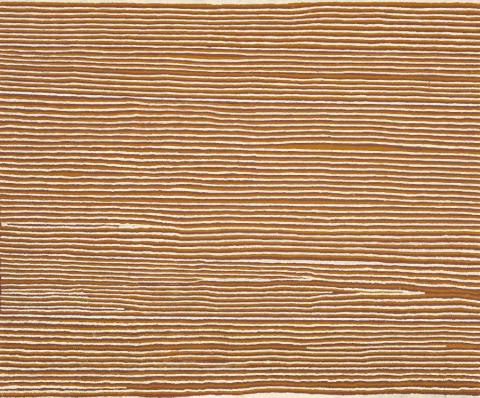SPEAR STRAIGHTENING AT THE CAMPSITE OF ILLYINGAUGAU, 1999
TURKEY TOLSON TJUPURRULA
synthetic polymer paint on linen
151.0 x 182.5 cm
inscribed verso: artist's name, size and Papunya Tula Artists cat. TT991091
Papunya Tula Artists, Alice Springs
Gallery Gabrielle Pizzi, Melbourne
Private collection, United States of America
Straightening the Spears 1999, synthetic polymer paint on canvas, 152.0 x 183.0 cm, in Perkins, H., One Sun One Moon: Aboriginal Art in Australia, Art Gallery of New South Wales, 2007, p. 186 (illus.), collection of the Art Gallery of New South Wales
First introduced by the artist as a theme in his painting in 1990, Spear Straightening is a subject Turkey Tolson Tjupurrula has returned to time and time again. As curator Hetti Perkins notes in relation to Tjupurrula's Spear Straightening paintings, 'while the role of the artist may be grounded in his or her relatedness to country... the aesthetic expression of this relationship is not necessarily bound by the parameters of traditional design.'1
Tjupurrula's straightening spear paintings are made up of parallel lines of alternating colour. Constructed using a technique where the artist applies paint in sections rather than in one continuous line, his works have a constantly varying surface giving them a sense of depth and shifting undulations. This painting is a magnificent example of both the subject matter and the artist's technique with the repeated lines of varying colour across the canvas creating a unique variegated surface.
The original certificate from Papunya Tula Artists described the subject matter of this painting thus: 'During Mythological times a group of men camped at the site of Illyingaungau near the secret cave of Mitukatjirri, south-east of the Kintore community. The rows of dots throughout this painting represent spears which the men are straightening. This is done by slightly warming the spear over a fire and straightening the spear while it is warm. These men were preparing their spears as they had heard of a possible confrontation with a group of men from the Tjikari area further to the north'.
1. Perkins, H., One Sun One Moon: Aboriginal Art in Australia, Art Gallery of New South Wales, Sydney, 2007, p. 184
